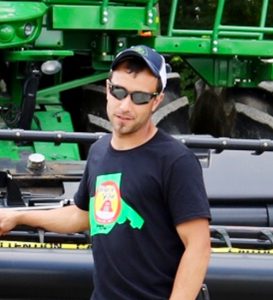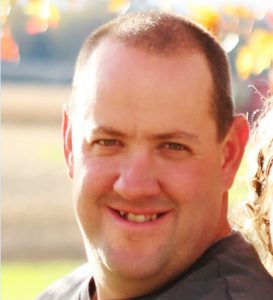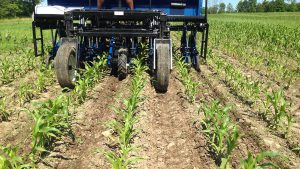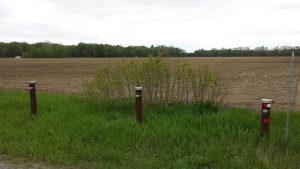Understanding precision agriculture
WHY DATA COLLECTION MATTERS TO YOUR FARM

BY THE TIME their equipment gets parked for the season, another kind of harvest is already getting underway when farmers grab their yield data off the combine.
Karon Cowan, owner of AgTech GIS, has been involved in precision agriculture for more than 25 years, and has worked with over a million acres of farmer data in that time.
She says that Ontario farmers are becoming more complex in the way they manage their fields and as a result, they want to know how to do more with all the data that’s coming into the combine or sitting on an office computer.
“When a grower touches or sees his or her own data, they have completely different conversations about their management practices with their service providers that are way above and beyond what’s the price of that product, or how much does that program cost,” says Cowan.
According to her, the most prevalent grower-level software is Ag leader’s SMS and Trimble’s Farm Works for organizing, cleaning, and manipulating mapped data.
Cowan says that farmers are also interested in cloud-based software, such as Climate FieldView or Operations Center from John Deere, that automatically upload yield, spray, and planting data from equipment to cloud servers.
The key difference between the two types of software, she explains, is that the cloud-based systems are designed more for viewing the data or sharing it with a trusted advisor.
If a farmer wants to manipulate their data or create management zones or prescription maps, they would still need software that’s purpose-built for the job.
But with all the different equipment manufacturers out there and software available, how do farmers — not to mention the consultants they are working with — keep all of those different data sources and formats straight?
“That just doesn’t even matter anymore for the most part. At this point in time, the ag retail and consultant sector is incredibly well-equipped to handle data whatever equipment the customer is running,” explains Cowan. “Any of the common software brands can handle multiple manufacturers’ data. So, farmers with a mixed fleet can use one software for all.”
When it comes to working with these software programs, Cowan says that they’ve come a long way towards being more straightforward and user-friendly, but there’s always going to be a learning curve.
“People have been told that proper data collection is hard, and so it becomes hard in everyone’s minds,” says Cowan. “But when they actually sit down and see they can import data with the click of a button, or perform a multi-year analysis with three clicks, it’s not so scary and actually kind of fun. Any new thing requires a time investment of some sort.”
Where Cowan has seen farmers have the most success is when they work with data on their own but also deal with a trusted service provider.
“It’s important to have your own data that you control,” says Cowan. “And when you’re actively managing and accessing your data, you’re also better equipped to get the best out of your service providers and take advantage of their knowledge and experience.”
What, then, are the best practices, tips, and tricks that farmers need to keep in mind so they can make the most out of their data? Precision agriculture consultants and farmers weigh in.

TONY BALKWILL
Independent agronomy specialist, owner of NithField Advanced Agronomy
Pulling data off the combine: Growers have two options, says Balkwill — to extract their data physically using a USB or remotely through the growing use of cellular systems that package and upload data to a cloud server. Once that data is in the cloud, Balkwill can quickly and easily create summaries of what his farmers have harvested, and then create soil sampling or fertility maps to help them plan.
Keys to collecting and organizing quality data: “First, make sure your equipment is calibrated and consistent. Even though your yield monitor might be off by a little bit because there are a lot of moving parts, the key to quality data is to have everything consistent. Once your monitor is close to being calibrated, just use it. Post-season, you can take weigh tickets and scales and re-correct that data to your actual yield.”
The second part, says Balkwill, is for growers to make sure they are storing raw data — sorted by year — in a central location and to backup hard drives that they or their agronomist can easily access.
“Even if you aren’t working with someone on that data right now, you might be at some point, so it’s beneficial if you hang on to the data because you don’t know how valuable it will be,” he says.
What are the benefits of having properly organized and saved data? Balkwill says agriculture is becoming more and more time sensitive and data intense, with farmers trying to cover more land with less people and equipment. For example, if a farmer wants to look at applying potash based on their crop removal system, having already-organized data eliminates the need to spend days cleaning data, and helps growers make efficient management decisions and get more work done.
“Good data can give you so much power as a management and evaluation tool. You don’t have to do anything too complex to collect a couple data layers accurately and get amazing results that will help shift your management practices.”

PAUL SULLIVAN
Agronomist, owner of P.T. Sullivan Agro Inc.
Pulling data off the combine: “The easiest way to get your data is to physically copy it off the combine using a USB stick onto your laptop, and get it saved to a secure location. We have six clients that are on MyJohnDeere, the web-based program, and we can track yield and application information as it’s uploaded. That way, we have access to their files and can see what’s been done.”
Keys to collecting and organizing quality data: “Label all your fields the same way, as basic as that sounds. Having everything properly labelled becomes really important — particularly for Farm Works software. This is an area where things can get really time consuming — especially when you have people involved that are not familiar with the fields, whether that’s your own employees or outside support services.”
What are the benefits of having properly organized and saved data? Sullivan says the single biggest benefit is that growers have their own report card for the crop. He adds that organized, multi-year data also allows growers to evaluate how their farm is evolving as new technology gets introduced, whether it’s new pieces of equipment, hybrids or new and old management strategies.
“Yield data becomes a way of evaluating your management approach instead of going with gut-feel,” says Sullivan. “Because we’re dealing with Mother Nature and making decisions on the go, growers are awesome at working by gut-feel because they’ve had to be. But data can really help tidy up those management decisions.”

TYLER MCBLAIN
Tyler McBlain farms with his father Barry in Brant County, growing corn, soybeans, and wheat. The McBlains have been generating yield maps for the past eight years and are now doing variable seeding, fertilizer, and variety trials.
How he organizes and sorts his data: “We’ll go through, edit all of the data and make sure all our yields are properly represented, because sometimes acres can be out and skew the data against your final weights and averages. We collect multi-year data and every field has its own file on our computer, which is important since we’re doing variety comparisons across every farm.”
Keys to collecting and using your data: McBlain says he aims to be as detailed and accurate as possible when collecting and entering his data off the combine.
“Put in as much detailed information as you can, such as the hybrid or field, otherwise you won’t be able to really pull any of that data apart later,” he says.
The biggest challenges: “The big one is time. Even in the winter it’s tough finding the time to tear apart and analyze your data as much as you’d like to. As well, finding the right computer program to manage your data, as well as one that talks properly to your equipment can be challenging.”
How having quality data benefits his business: McBlain says data ultimately helps him make the right management decisions — especially since he and his father farm on several different soil types, from heavy clays to clay-loam, and need to match the right hybrid to each area.
“Having multi-year data helps us see what hybrid performs best and where,” he says. “We’re also starting into variable rate fertilizer, and are seeing a cost savings in being able to put fertilizer where it’s most needed or apply less where there’s lower potential.”

PAUL HAGEY
Paul Hagey grows corn, soybeans, and wheat for White Feather Farms in Durham Region. He has been collecting yield data for the past seven years and creating variable rate prescriptions and variety tracking for the past four.
How he organizes and sorts his data: “Our process is fairly simple. For every crop, I’ll take my USB stick out of the combine and upload it into the computer. That data then gets reviewed, verified, and then we remove yield numbers that don’t jive or make sense.”
Keys to collecting and using your data: In the off-season, Hagey will set up everything from his field boundaries and names, to his crops, varieties, and prescriptions in the Farm Works software.
“That way, when you’re bringing data from the combine into the computer, it all has a home. I think to make the whole data collection process as seamless as possible, you need to take time to get organized and prepped,” he says. “If you don’t get so far, and you start plugging stuff into the monitor — like different names and operators — it can get really complicated.”
The biggest challenges: “Every year is so variable. You can see a wet year, dry year, and another year where the crop gets hit with hail. A lot of that data is skewed because it’s not the norm. It takes years of data to normalize an average year that you can actually use to build variable rate prescription for your fertilizer or planting population. It’s a challenge getting those years of data together and you need to know the history of your fields.”
How having quality data benefits his business: Hagey says he has been putting multiple varieties out in the field with his precision planter, then taking the data of what’s been planted and entering it into his combine for harvest. That way, he’s able to collect sets of yield data of every individual variety. He has also been using data to work through variable plant population.
“We’re using data to figure out the best parts of our fields to increase populations in corn and soybean populations, as well as the bad parts where we can cut back on seeding,” says Hagey. “That also means seed savings and a better way to mitigate the risk of disease pressure, like white mould, in specific parts of the field.”

JASON ROBINSON
Jason Robinson farms corn, soybeans, and sweet corn on the tobacco plains in Courtland, Ontario. He has been involved in precision agriculture for around 10 years, both as a farmer and technical consultant.
How he organizes and sorts his data: “In the fall, I’ll generally just make sure everything gets transferred over to our office computer and start working on it field-by-field after Christmas. Generally, I’ll go through the varieties and soil types. We always do plots on every variety, which gives me information for next year for populations on variable rate.”
Keys to collecting and using your data: Robinson says the biggest thing is to actually get the data and do something with it. He’s seen quite a few farmers with new yield monitors will watch their data as they go across the field – but that’s as far as their analysis goes.
“I tell guys to look at their yield data just so they can start planning for soil sample zones. A yield map can help show if there are problem spots you need to go and address. A lot of the time, the farmer knows about their trouble spots, but doesn’t know what’s actually wrong with them.”
The biggest challenges: “I find it’s having the time to physically sit down and just go at the data. The other biggest problem has been to find software to do what I wanted it to do. I ran two different programs before I settled on SMS, but it’s still not 100 per cent the way I want it. The biggest thing I find is that it’s never simple. It’s not a one-click button to do something like normalizing yield, but a process you have to learn.”
How having quality data benefits his business: Robinson says that having multi-year data organized and available reinforces his management decisions, such as trying different seed populations or solving field and fertility issues.
“If I see there’s a problem spot in the bean field I harvested yesterday, I can make a soil sample map and either do the sampling myself or hand it off to a third party,” he explains. “Once the sampling’s been done, it can be added to other layers or work into a prescription map for next year.” •
POINTS TO REMEMBER
To collect high quality data, start by making sure your equipment is well calibrated. If you work with a custom provider for spraying or combining, ask them to provide your yield data. Once your data is off the combine, don’t just save it to one computer. Keep that data backed up in multiple areas, or consider investing in cloud-based services so you can easily share with your consultant. Be as detailed and consistent as possible when organizing that data, such as keeping your fields clearly labelled. This can help you look at trends and trouble spots year over year. Put in the time to learn software — like SMS or Farm Works — to analyze your data, or find a consultant that can do the work for you.
This project was funded in part through Growing Forward 2 (GF2), a federal-provincial-territorial initiative. The Agricultural Adaptation Council assists in the delivery of GF2 in Ontario.
Precision Agriculture Advancement for Ontario: This article is part of a series dedicated to helping farmers understand and implement precision agriculture technology. It is based on research conducted by Nicole Rabe, Ian McDonald, and Ben Rosser at OMAFRA, in conjunction with Mike Duncan, Sarah Lepp, and Gregor MacLean at Niagara College.
For more on precision agriculture go to: www.gfo.ca/ Research/Understanding-Precision-Ag. •

























